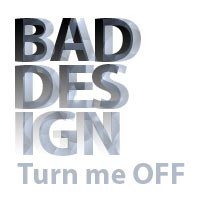When Good Web Design goes Bad

I’m the first person to admit that looking good is a big part of online success.
In the virtual world, there are no non-visual cues that a potential buyer/reader/subscriber/customer can use to judge your credibility, so the professionalism and the tone of your website speaks volumes. A little goes a long way, though; I see a lot of sites that feel like they’re just trying too hard. Here are three common mistakes in web design I see, and how you can avoid them.
Too Many Adverts
This is a problem I have never quite understood. I see small businesses who have a sales page listing their services – say, “blogger in Toronto” – and then they plaster Google Adsense ads all around the page. They obviously haven’t clued in that Google Adsense is contextual, so those ads are more than likely for your competition. This problem also applies for massive, flashy banner ads that distract from whatever service or product you are offering.
Every situation is different, but my generic advice for this situation is such: If you make more money selling one of your ‘things’ than by promoting someone else’s, stop advertising. For most people, it doesn’t make sense to have a few pennies from Google when you could easily bring in more profit by focusing the attention on your great stuff instead.
If you do decide to have advertising – for example, if you’re an online magazine and that’s is your primary revenue source, then don’t oversell your virtual real estate. “Widgetmania” is a real turnoff to readers and if you have hundreds of banner ads, the click through on each individual one just gets lower and lower.
Too Many “Innovative” Features
If your site is based entirely on flash technology, go have a quick peek at it on an iPhone or any other mobile browser. Not so innovative, eh? I’m all for abandoning support for Internet Explorer 6 (if you don’t know why, don’t worry about it), but sometimes websites push the edge so far that they leave half of their buying customers behind.
This is a very easy problem to fix: test, test, test. With real people. Not your developers overseas, not your internal sales team, but real people who are in your target market. Does your site load slowly on their machine? Do they get errors because they’re on a newer browser, like Chrome, or maybe an older version of Internet Explorer? Don’t alienate a potential customer from the start because you don’t support their technology. Test!
Too Many Menu Choices
Last but not least is what I appetizingly call “menu bloat” You know the menu – you keep clicking and it never seems to end. Layers and layers and layers, and tiny names and buttons to squeeze all those options on the page. I can’t tell you if your menu is too big or too small or just right. But if you think of it a bit like a grocery store, you’re OK:
- If I’m looking for something particular, is it in a logical place that I can easily get to?
- If I read the signs and follow them, am I not surprised by what I find when I get there?
Don’t follow the grocery store’s lead and change everything around every month. But do take an honest look through your menu. Is it as straightforward as you had intended?
Less is More
I have been accused before of ‘minimalist’ design practices. I’m ok with that. I have decent conversion rates, and the styles I use fit with my personal tastes and (more importantly) with my target reader’s taste. But in many cases, a healthy dose of less is more could be given to a lot of sites out there. Think about it: if you did some decluttering and spring cleaning, could you focus some attention on the stuff that makes your website more profitable? Try it for a month and see.
 Does Your Site Design Turn Off Visitors
Does Your Site Design Turn Off Visitors Is a Custom Design Essential to Your Blog’s Success?
Is a Custom Design Essential to Your Blog’s Success? 5 Easy Ways To Impress More Of Your Website Visitors
5 Easy Ways To Impress More Of Your Website Visitors Should a new blogger get a custom design for his blog?
Should a new blogger get a custom design for his blog?
{ 30 Responses }